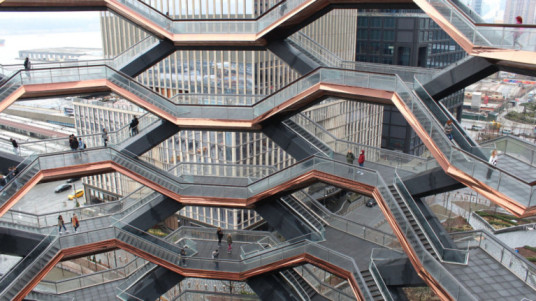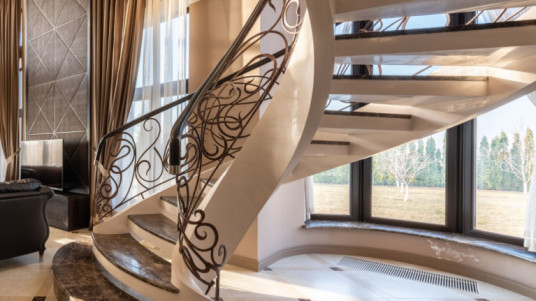
Types of Stairs in Building Construction: A Complete Guide
When considering the types of stairs in building construction, it’s essential to choose the right design that balances functionality, space, and aesthetics. Whether you need a straight staircase or a more intricate geometrical design, understanding the different types of stairs in building construction can help you make the best decision for your project. Staircases are essential in connecting spaces, but they also serve as a striking architectural element in a building. Discover some staircase ideas that are truly next level to elevate your space.
What is a Staircase?
A staircase is a set of steps that leads from one floor to the other, and it usually has several flights in between landings. Stairs are an essential element in any multi-story building because they help to ensure safe and easy movement from one floor to another.
Types of Stairs in Building Construction
Actually, there are quite a few different kinds of stairs that are used in buildings; each type offers a wide range of benefits by design, available space, or merely style preference. So, let’s look at some of the most commonly used types of stairs:
1. Straight Stairs
Straight stairs are the most basic and common type. These stairs go straight up and down with no changes in direction. They are simple to construct, cost-effective, and therefore widely used in residential and commercial buildings.
2. Quarter Turn Stairs
Quarter turn stairs make a 90-degree turn, either left or right, usually after a landing. This type of staircase saves space and is often used in houses where the staircase needs to fit into a corner. Quarter turn stairs are one variation of U-type stairs, which offer both compactness and aesthetic appeal.
3. Half Turn Stairs (U-Type)
Half turn stairs, also known as U-type stairs, make a 180-degree turn, forming a U-shape. These stairs are perfect for smaller buildings as they allow for compact designs that can fit into limited spaces.
4. Geometrical Stairs
Geometrical stairs are characterized by curved or spiral elements and typically lack landings with sharp angles. These stairs are sleek and modern, making them popular in contemporary architectural designs. The curves of geometrical stairs are not only visually striking but also present challenges in construction.
5. Three Quarter Turns Stairs
Three-quarter turn stairs feature two landings and involve a 270-degree turn. This design is often used in multi-story buildings, providing a more compact footprint compared to half-turn stairs. These stairs are common in commercial buildings or homes with multiple levels.
6. Open Newel Stairs
An open newel staircase has landings and open spaces between flights, creating the appearance of a wider, more open stairway. These stairs provide a sense of freedom and are typically used in large, spacious buildings.
7. Winder Stairs
Winder stairs turn around a corner without the need for a landing. The steps are tapered to fit into the available space, making this design a favorite for those looking to save space.
8. Circular Stairs
Circular stairs take a circular, looping approach and are ideal for spaces where floor area is limited. They are compact, functional, and add an aesthetic touch to lofts or tight spaces.
9. Spiral Stairs
Spiral staircases are tightly wound around a central column, allowing them to occupy minimal space. However, their steepness makes them less suitable for households with children or elderly residents. Explore modern spiral staircase designs for inspiration.
10. Bifurcated Stairs
A bifurcated staircase begins as a single set of stairs and splits into two flights. This type of stair is often seen in large, grand buildings like hotels or stately homes, as it creates an imposing and elegant entrance..
Different Types of Staircase Steps:
Even the steps themselves can be an important consideration in choosing a design for a staircase. The different kinds of steps can affect the look and safety of the staircase.
- Tread: the flat part where you step on.
- Riser: The vertical element between treads.
- Nosing: The edge of the tread over the riser.
- Landing: A flat platform that exists between flights of stairs.
Selecting the Best Staircase
Some considerations for choosing the right staircase for your project include the following.
- Space: A lot of available space. When the area is small, a spiral or winder stair may be the most suitable.
- Safety: Avoid a steep, narrow staircase like spiral stairs for people with young children or elderly people.
- Aesthetics: Are you interested in a really modern, minimalist look, or a more grand and traditional look?
- Budget: The straight stairs would be considered the cheapest option, while geometric or bifurcated stairs tend to be more expensive due to the complex designs.
At Infra Ratepersqft, we provide expert advice and high-quality materials for building your staircase. Whether you’re looking for a simple straight staircase or a more intricate, custom design, we have the solutions to meet your needs.
Conclusion
The types of stairs in building construction you choose will impact the safety, functionality, and aesthetic appeal of your building. Whether you opt for a simple straight staircase or an elaborate design like bifurcated or geometrical stairs, your choice should align with both your space and design vision. No matter the type of staircase, the design and functionality should elevate the overall appeal of your space. Check out next-level staircase ideas for more inspiration.
Visit Infra Ratepersqft for expert advice and the best staircase solutions for your project.

Frequently Asked Questions
1. How many types of stairs are there in building construction?
There are many types of stairs, including straight, U-type, open newel, circular, spiral, and geometrical stairs. Each has its unique benefits based on your needs and available space.
2. What is the most space-saving staircase design?
Spiral stairs and winder stairs are highly space-efficient due to their compact design, making them ideal for smaller areas.
3. What is a three-quarter turn stair?
A three-quarter turn stair has two landings and a 270-degree turn, commonly found in multi-level buildings or spaces with limited room.



